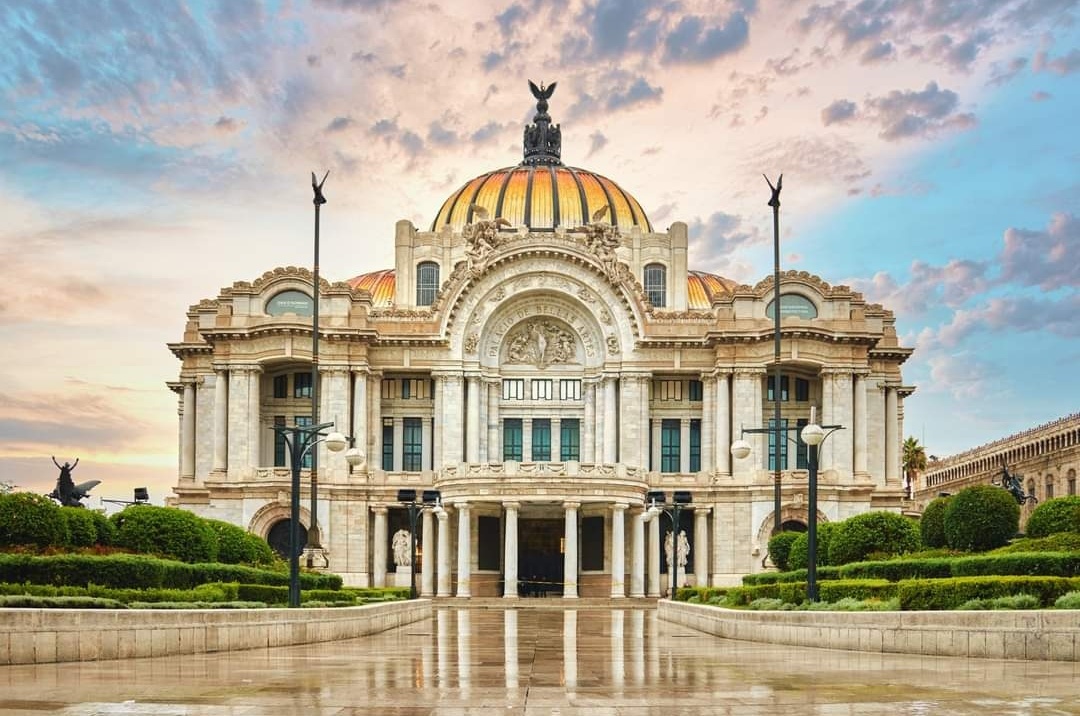
In the heart of Mexico City stands a cultural gem that has witnessed the evolution of art, architecture, and society over the years. The Palacio de Bellas Artes, often referred to as the “Palace of Fine Arts,” is not just a building; it’s a living testament to Mexico’s rich artistic heritage and its ongoing commitment to nurturing creativity. This article delves into the building’s history and its remarkable journey through time, capturing the essence of its architectural splendor and the development that has shaped it into an iconic landmark.
Architectural fusion: a vision takes shape
The story of the Palacio de Bellas Artes began in the early 20th century when the Mexican government decided to create a space that would celebrate the nation’s artistic achievements. The task of designing this ambitious project fell to Italian architect Adamo Boari. Boari’s vision was a fusion of architectural styles, blending Neoclassical and Art Nouveau elements to create a harmonious masterpiece.
Construction began in 1904, and the project presented numerous challenges, including technical and financial obstacles. The construction was briefly interrupted by the Mexican Revolution, which further complicated the timeline. Despite these challenges, Boari’s design and his commitment to artistic excellence never wavered. Finally, the building has been finished in 1934.
Bellas Artes: the marble wonder and the majestic dome
One of the most striking features of the Palacio de Bellas Artes is its stunning exterior, adorned with white Carrara marble and colorful ceramic tiles. This combination of materials creates a visual feast for the eyes and showcases the architectural intricacies that define the structure. The Neoclassical facade, characterized by its symmetrical design and ornate detailing, pays homage to Mexico’s historical and artistic roots.
The crowning glory of the palace is its majestic dome, an engineering marvel that appears to float above the building. Made of iron and covered in gleaming gold leaf, the dome is a symbol of Mexico’s commitment to embracing modernity while honoring its cultural heritage. Its interior is just as awe-inspiring, with murals by renowned artists Diego Rivera, Rufino Tamayo, and David Alfaro Siqueiros that narrate Mexico’s history and spirit.
Evolution and adaptation: a cultural hub
As the years passed, the Palacio de Bellas Artes continued to evolve, adapting to the changing artistic landscape and societal demands. It became a hub for not only visual arts but also music, dance, and theater. The main theater’s exceptional acoustics and opulent decor made it a preferred venue for various performances, from operas to symphonies and ballets.
Over time, the Palace’s significance grew, attracting artists and audiences from around the world. Its walls bore witness to groundbreaking performances, political debates, and cultural revolutions. It became a space where tradition and innovation converged, and where artistic expression was both celebrated and challenged.
Bellas Artes: a haven for visual arts
Bellas Artes is renowned for its diverse collection of visual arts that span various periods and styles. The National Museum of Art, housed within the palace, boasts a rich assortment of Mexican artwork, from colonial religious paintings to modern masterpieces by the likes of Diego Rivera, David Alfaro Siqueiros, and Frida Kahlo. Visitors can journey through the evolution of Mexican art, witnessing the socio-cultural transformations that have shaped the nation’s identity.
The museum’s rotating exhibitions further enrich its offerings, introducing audiences to international artists and cutting-edge contemporary works. This dynamic approach ensures that the visual arts scene at Bellas Artes remains fresh, vibrant, and relevant to the ever-changing world of art.
Preserving the past, embracing the future
The Palacio de Bellas Artes underwent extensive renovations in the late 20th century to ensure its preservation for future generations. The restoration efforts aimed to maintain the building’s architectural integrity while incorporating modern technologies to enhance its functionality. The restoration process was a delicate balance between safeguarding the past and embracing the demands of the present.
Today, the Palacio de Bellas Artes stands as a living tribute to Mexico’s artistic and cultural heritage. Its halls continue to echo with the melodies of the past and the innovations of the present. As Mexico City’s cultural nucleus, it welcomes artists, performers, and enthusiasts who seek inspiration and connection through the power of creativity.
The Palacio de Bellas Artes is more than a building; it’s a testament to Mexico’s enduring commitment to the arts and its ability to adapt while staying true to its roots. From its architectural inception to its role as a dynamic cultural hub, the palace has withstood the test of time, remaining a symbol of Mexico’s artistic resilience and its unwavering dedication to beauty, expression, and imagination.
Actual program can be found here: Program Bellas Artes
Opening hours:
Monday: closed
Tuesday – Sunday: 10:00 – 17:00
How to get there from Casa de Chiles?
Take the metro from Chapultepec direction Pantitlán. Change at Salto de Agua to the line no 8, direction Garibaldi. Get out at the station Bellas Artes.
